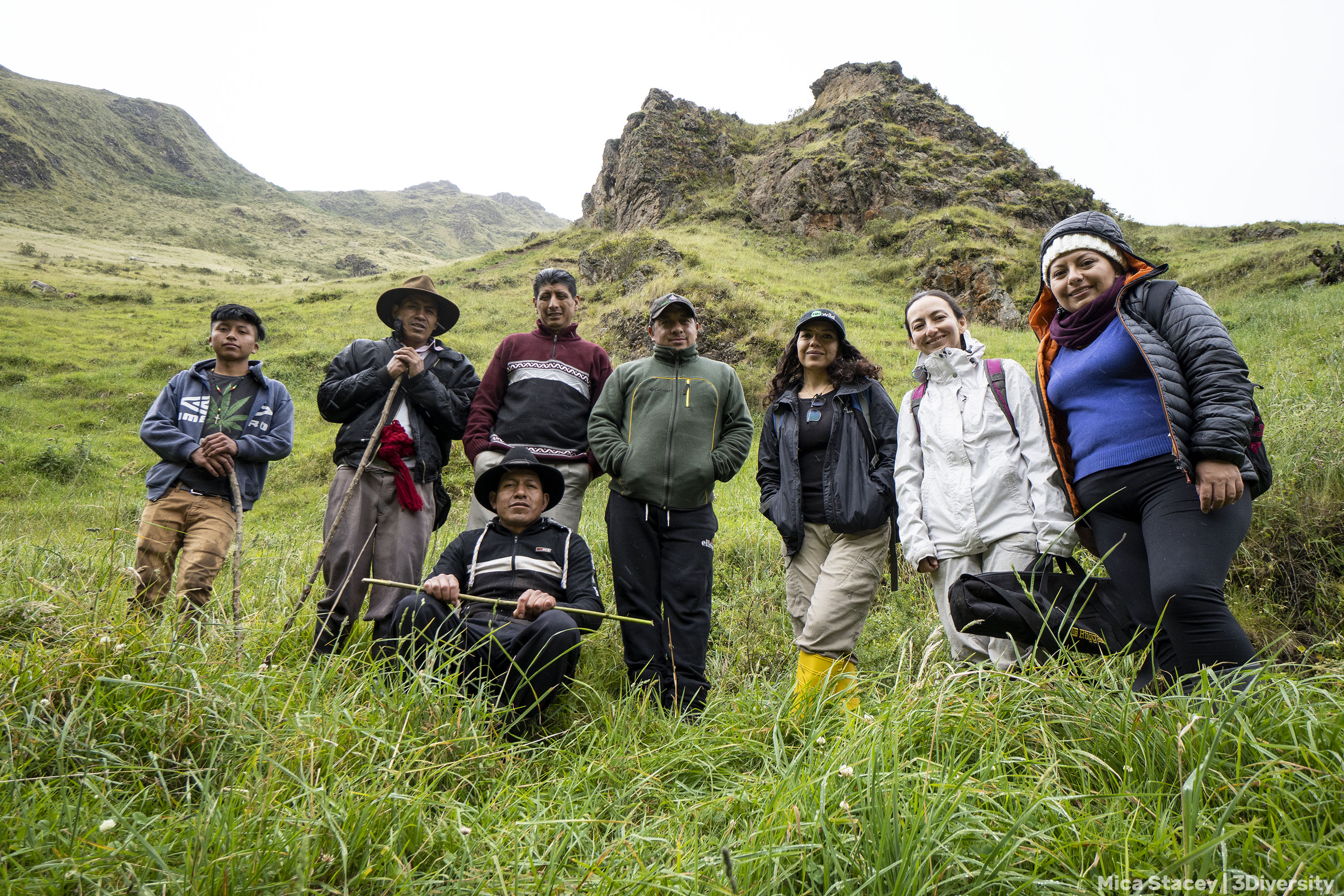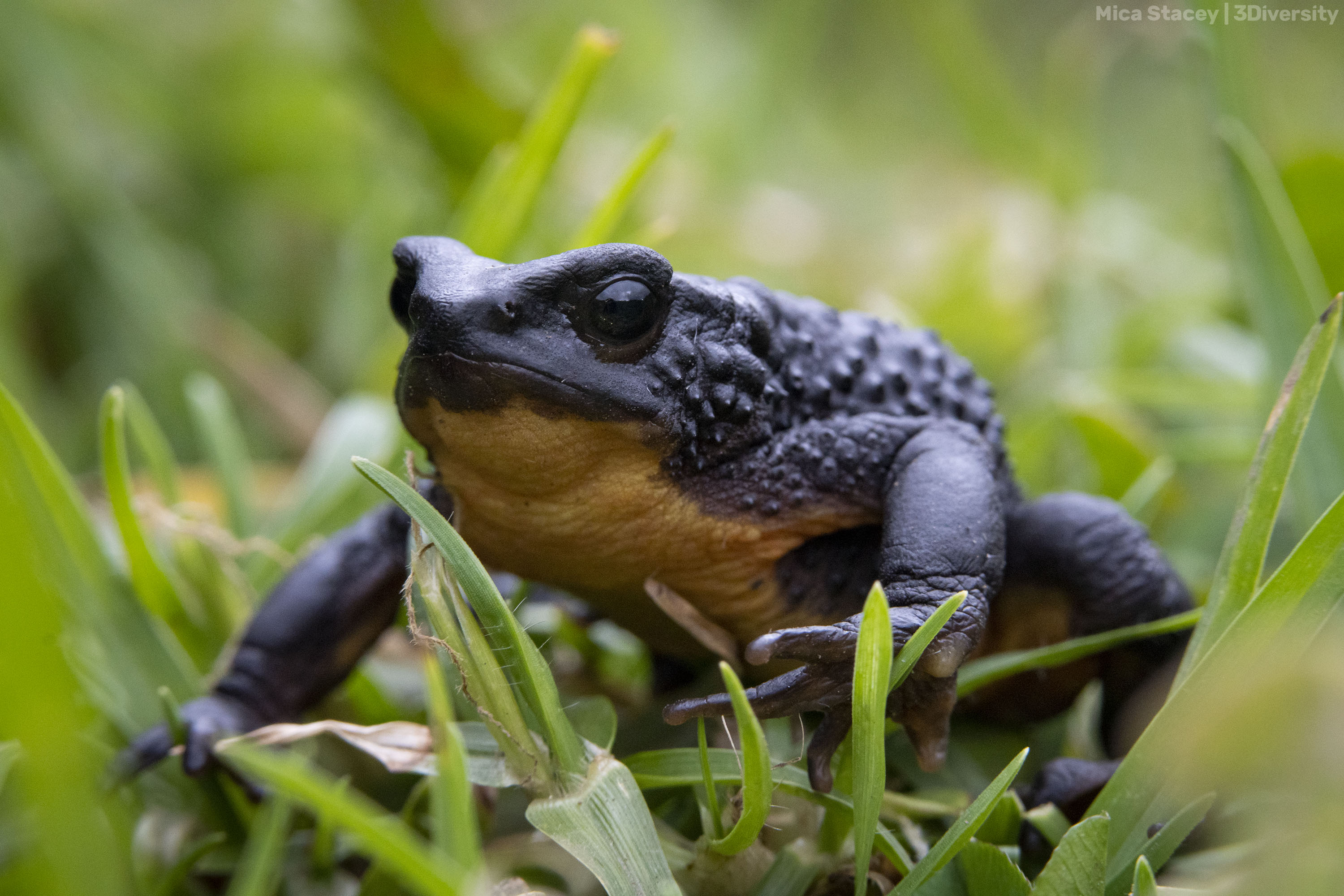Five years after the rediscovery of Atelopus ignescens, an emblematic species of harlequin toad, researchers and community leaders are joining forces to conserve it in its last refuge.
This text was originally published by the IUCN. Read the Spanish version of this text here. The Amphibian Survival Alliance (ASA) supports this project through the ASA Phil Bishop Conservation Grant. Learn more here.
Those who lived their childhood in the central-northern Ecuadorian Andes, before the 1980s, have surely heard of the jambato; a playmate, inspiration for popular sayings and part of the daily life of the inhabitants of these lands. Due to its extraordinary abundance, it became the mental image of the word “toad”. Therefore, it is not surprising that the Kichwa word for these amphibians, “jambatu”, was adapted to Spanish as a common name for this species.
However, a generation later, it was already a legend. While scientists around the world were warning of a wave of amphibian extinctions (especially of harlequin toads), children were hearing stories of absent jambatos. After an intense search, in 1988, a group of Ecuadorian scientists announced this species as “possibly extinct”.
Over time it faded from the collective memory until 2016, when the jambato was heard again in the media. David Jailaca, a 10-year-old boy, rediscovered it when he was cutting alfalfa at home, in a remote village in Cotopaxi province. For him it was just another toad in the area, as he did not know that it was such a sought-after species. Only when he heard that a reward was offered for whoever found it, he knew how special it was. After this, it was confirmed that the jambato was still surviving in this distant valley. The news made history.
Immediately, the Centro Jambatu initiated a captive breeding program which has succeeded in reproducing the species under controlled conditions and currently has a backup population in its facilities.
However, the status of the wild population was unknown. For this reason, in June 2021, a new phase of research was initiated, focused on understanding the perceptions and characteristics of the local community to identify opportunities and stakeholders, and to lay the groundwork for designing a work plan.
Shortly after, seed funding was obtained from the Amphibian Survival Alliance, through the ASA Phil Bishop Amphibian Conservation Grant; and from Stiftung-Artenschutz, from the Amphibian Conservation Fund, to conduct a more in-depth investigation on the population status of the jambato and work with the community. This first stage began in November of the same year.
Currently, through the coordination of local leaders and researchers, the funds are being managed and the project activities are being carried out. Thanks to the support of partner institutions, this species is monitored monthly and a small, apparently healthy population has been identified. The finding of gravid females and tadpoles indicates that the population is reproducing and there is a close relationship with the agricultural landscape. However, many questions remain to be answered.
For this reason, working with the communities is extremely important. Together with the parish authorities, activities are being coordinated to promote a dialogue of knowledge, inquiring about the previous knowledge of this species and making known its biology and role within the ecosystems that they share with the people. In addition, there are plans to carry out experiential activities so that the people of the community can generate a greater bond with the jambato, raising awareness about the importance of respecting and conserving this species and all biodiversity.
Despite these efforts, the extremely critical situation of this species has motivated the team of researchers to seek more organizations with whom they have created the “Alianza por el Jambato” (Alliance for the Jambato). This Alliance seeks to unite efforts to position the jambato, Atelopus ignescens, as an emblematic species and save it from extinction, through research and conservation actions both in situ and ex situ, involving the local community.
To achieve this, an integrated approach is maintained that includes:
- Assessing the conservation status of the last known population of this species and its threats (e.g., chytrid fungus, climate change) to develop mitigation and/or adaptation measures;
- Raise awareness and develop capacities in the community to support its conservation;
- Generate an action plan established for in situ conservation involving the local community and proposing activities that benefit them (e.g. nature tourism and/or agro-ecology);
- Maintain and support ex situ conservation of the species in order to have a backup population for future reintroductions and/or translocations;
- Execute a communication strategy to report on the progress of the project and obtain the support needed to make it sustainable.
The team’s greatest achievement has been the joining of efforts to achieve an interdisciplinary and collaborative working group. Their main goal is to achieve the conservation of the last known population of Atelopus ignescens (Critically Endangered) through research work that will lead them to develop concrete conservation actions; and the participatory and committed involvement of the local community.
We may never fully understand why the jambato disappeared or why it survived in this small valley. But we need to identify the local threats that could lead to its ultimate extinction and work hard to mitigate them. We also need to enhance the factors that allow it to thrive and, in this, local communities play a fundamental role because they are part of the same ecological network. For a long time it was the most dramatic symbol of amphibian extinctions in Ecuador; now we want it to become an icon of conservation.
Together we can save the jambato that “came back from extinction”. We can’t miss this second chance! Fill out this form (in Spanish) to learn how you can get involved.
The Alianza por el Jambato is made up of the following members: María del Carmen Vizcaíno-Barba (FLACSO Ecuador y Sociedad Ecuatoriana de Etnobiología ); Juan Manuel Guayasamín, Mateo Vega, Amanda B. Quezada (Universidad San Francisco de Quito); David Parra-Puente (Fundación Jocotoco); Mónica Páez-Vacas, Sofía Carvajal-Endara, David Salazar, Gabriela Maldonado-Castro (Universidad Tecnológica Indoamérica); Andrea Terán-Valdez, Luis A. Coloma (Centro Jambatu); Gustavo Pazmiño-Otamendi, Andrés Marmol-Guijarro, Micaela Stacey-Solís, Andrea Varela-Jaramillo (3Diversity); Martín R. Bustamante, Gabriela Arévalo, Soledad Torres, Stefany Obando (Zoológico de Quito); Lina Valencia (Re:wild); Luis Fernando Marin da Fonte (Amphibian Survival Alliance); María José Navarrete, Laura Gómez-Mesa (independent researchers); Stiftung-Artenschutz; Atelopus Survival Initiative; and the International Union for Conservation of Nature (IUCN) – Regional Office for South America. The parish government in which the jambato survived and the local community are also instrumental in this joint effort.
For more information you can contact: [email protected]; María del Carmen Vizcaíno ([email protected]) and/or Juan Manuel Guayasamín ([email protected]).

Photos by Mica Stacey.

